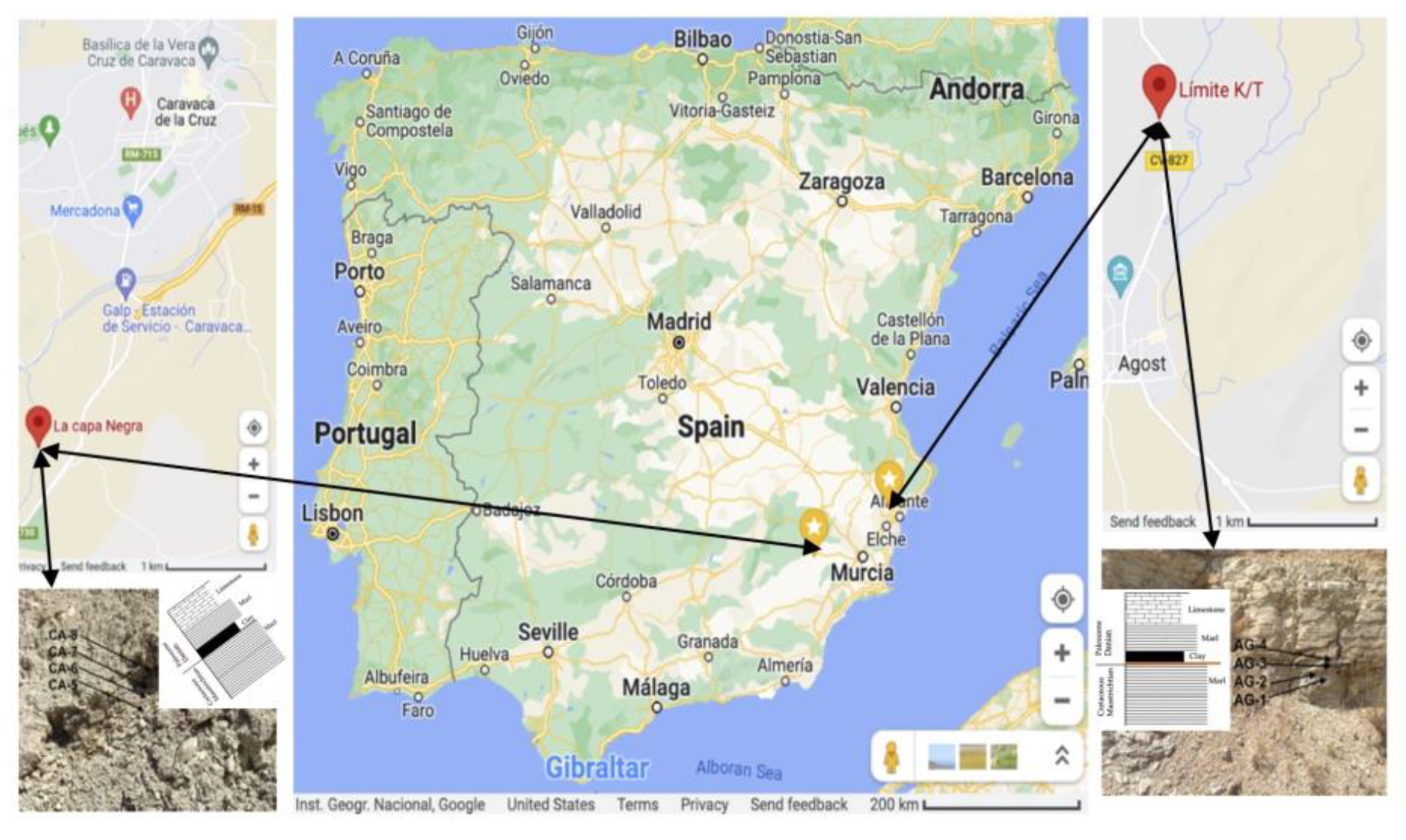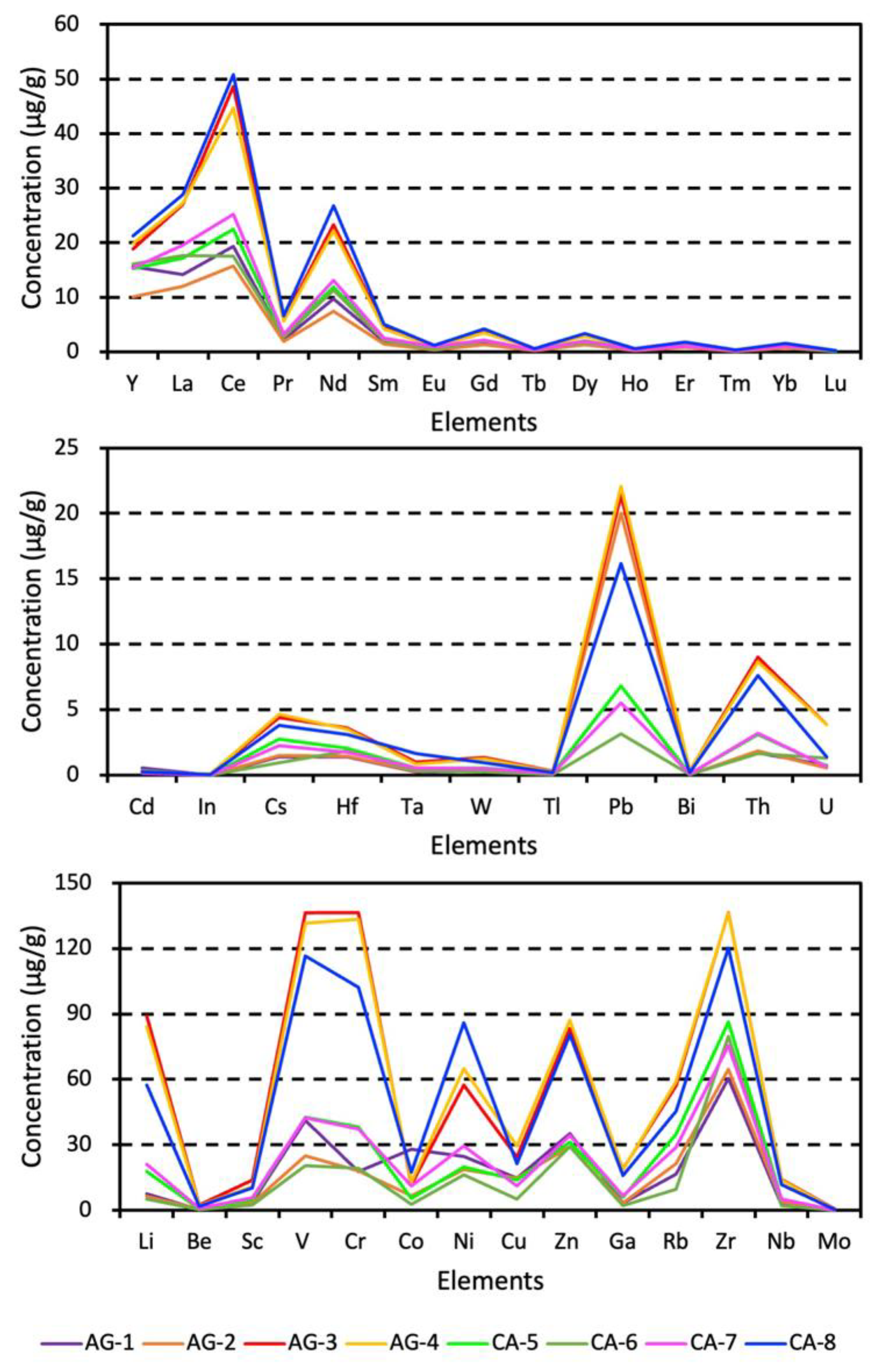X-ray Diffraction and Trace Element Analyses of K/Pg Boundary Samples Collected from Agost and Caravaca, Spain
Abstract
1. Introduction
2. Location and Stratigraphy
3. Methods of Analyses
4. Results
4.1. XRD Analyses
4.2. Major Elements
4.3. Trace and REE Elements
5. Discussion
6. Conclusions
Supplementary Materials
Author Contributions
Funding
Data Availability Statement
Acknowledgments
Conflicts of Interest
References
- Irizarry, K.M.; Witts, J.D.; Garb, M.P.; Rashkova, A.; Landman, N.H.; Patzkowsky, M.E. Faunal and stratigraphic analysis of the basal Cretaceous-Paleogene (K-Pg) boundary event deposits, Brazos River, Texas, USA. Palaeogeog. Palaeoclim. Palaeoecol. 2023, 610, 111334. [Google Scholar] [CrossRef]
- King, D.T., Jr.; Petruny, L.W. Impact Spherule-Bearing, Cretaceous-Tertiary Boundary Sand Body, Shell Creek Stratigraphic Section, Alabama, USA; GSA Special Paper 437; Geological Society of America: Boulder, CO, USA, 2008; pp. 179–187. [Google Scholar]
- Keller, G.; Stinnesbeck, W.; Adatte, T.; Stüben, D. Multiple impacts across the Cretaceous–Tertiary boundary. Earth-Sci. Rev. 2003, 62, 327–363. [Google Scholar] [CrossRef]
- Pal, S.; Shrivastava, J.P.; Mukhopadhyay, S.K. Physils and organic matter-base palaeoenvironmental records of the K/Pg boundary transition from the late Cretaceous-early Palaeogene succession of the Um-Sohryngkew River section of Meghalaya, India. Geochemistry 2015, 75, 445–463. [Google Scholar] [CrossRef]
- Schmitz, B. Metal precipitation in the Cretaceous-Tertiary boundary clay at Stevns Klint, Denmark. Geochim. Cosmochim. Acta 1985, 49, 2361–2370. [Google Scholar] [CrossRef]
- Elliott, W.C. Origin of the Mg-smectite at the Cretaceous/Tertiary (K/T) boundary at Stevns Klint, Denmark. Clays Clay Miner. 1993, 41, 442–452. [Google Scholar] [CrossRef]
- Jones, H.L.; Westerhold, T.; Birch, H.; Hull, P.; Hédi Negra, M.; Röhl, U.; Sepúlveda, J.; Vellekoop, J.; Whiteside, J.H.; Alegret, L.; et al. Stratigraphy of the Cretaceous/Paleogene (K/Pg) boundary at the Global Stratotype Section and Point (GSSP) in El Kef, Tunisia: New insights from the El Kef Coring Project. Geol. Soc. Am. Bull. 2023. [Google Scholar] [CrossRef]
- Roy, P.; Parthasarathy, G.; Sreenivas, B. Clay minerals and the adsorption of fullerenes: Clues from iridium-enriched Cretaceous-Palaeogene Anjar intertrappean beds, Kachchh district, Gujarat, India. Current Sci. 2023, 124, 78–93. [Google Scholar] [CrossRef]
- Molina, E.; Alegret, L.; Arenillas, I.; Arz, J.A. The Cretaceous/Paleogene boundary at the Agost section revisited: Paleoenvironmental reconstruction and mass extinction pattern. J. Iberian Geol. 2004, 31, 135–148. [Google Scholar]
- de Oca, C.S.M.; Martínez-Ruiz, F.; Rodríguez-Tovar, F.J. Bottom-water conditions in a marine basin after the Cretaceous–Paleogene impact event: Timing the recovery of oxygen levels and productivity. PLoS ONE 2013, 8, e82242. [Google Scholar]
- Smit, J. The section of the Barranco del Gredero (Caravaca, SE Spain): A crucial section for the Cretaceous/Tertiary boundary impact extinction hypothesis. J. Iberian Geol. 2004, 31, 181–193. [Google Scholar]
- Drits, V.A.; Lindgreen, H.; Sakharov, B.A.; Jakobsen, H.J.; Zviagina, B.B. The detailed structure and origin of clay minerals at the Cretaceous/Tertiary boundary, Stevns Klint (Denmark). Clay Miner. 2004, 39, 367–390. [Google Scholar] [CrossRef]
- Mustafa, A.I.; Mansurbeg, H.; Mohialdeen, I.M. Petrography and Clay Mineral Variations Across the Cretaceous/Paleogene (K/Pg) Boundary, Sulaimani, Kurdistan Region, Iraq. Iraqi Geol. J. 2022, 55, 16–34. [Google Scholar] [CrossRef]
- Dill, H.G.; Dohrmann, R.; Kaufhold, S.; Weber, B. Clay mineralogy and chemistry of fine-grained sediments. Environment analysis around the K/P boundary at Sekarna/Kasserine Island, Tunisia. Neues Jahrb. Mineral-Abh. 2011, 188, 285–296. [Google Scholar] [CrossRef]
- Stüben, D.; Kramar, U.; Harting, M.; Stinnesbeck, W.; Keller, G. High-resolution geochemical record of Cretaceous-Tertiary boundary sections in Mexico: New constraints on the K/T and Chicxulub events. Geochim. Cosmochim. Acta 2005, 69, 2559–2579. [Google Scholar] [CrossRef]
- GB/T 14506.30-2010 (GB/T14506.30-2010); Methods for Chemical Analysis of Silicate Rocks—Part 30: Determination of 44 Elements. Standards Press of China: Beijing, China, 2010; 20p. (In Chinese)
- Ruíz, F.M.; Huertas, M.O.; Palomo, I.; Barbieri, M. The geochemistry and mineralogy of the Cretaceous-Tertiary boundary at Agost (southeast Spain). Chem. Geol. 1992, 95, 265–281. [Google Scholar] [CrossRef]
- Ortega, M.; Palomo, I.; Martinez, F.; González, I. Geological factors controlling clay mineral patterns across the Cretaceous-Tertiary boundary in Mediterranean and Atlantic sections. Clay Miner. 1998, 33, 483–500. [Google Scholar] [CrossRef]
- Quitté, G.; Robin, E.; Levasseur, S.; Capmas, F.; Rocchia, R.; Birck, J.L.; AllÈGre, C.J. Osmium, tungsten, and chromium isotopes in sediments and in Ni-rich spinel at the K-T boundary: Signature of a chondritic impactor. Meteorit. Planet. Sci. 2007, 42, 1567–1580. [Google Scholar] [CrossRef]
- Abboud, I.A. Iridium contents in the Late Cretaceous-Early Tertiary clays in relation to the K/T boundary, North Jordan. J. Afr. Earth Sci. 2016, 118, 107–119. [Google Scholar] [CrossRef]
- Wigforss-Lange, J.; Vajda, V.; Ocampo, A. Trace element concentrations in the Mexico-Belize ejecta layer: A link between the Chicxulub impact and the global Cretaceous-Paleogene boundary. Meteorit. Planet. Sci. 2007, 42, 1871–1882. [Google Scholar] [CrossRef]
- Schmitz, B.; Asaro, F.; Michel, H.V.; Thierstein, H.R.; Huber, B.T. 39. Elemental stratigraphy across the Cretaceous/Tertiary Boundary in Hole 738C. Proc. Ocean. Drill. Program Sci. Results 1991, 119, 719–730. [Google Scholar]
- Premović, P.I. Cretaceous-Paleogene boundary clays from Spain and New Zealand: Arsenic anomalies. Open Geosci. 2015, 7, 721–731. [Google Scholar] [CrossRef]
- Smit, J.; Kate, W.T. Trace-element patterns at the Cretaceous-Tertiary boundary—Consequences of a large impact. Cretac. Res. 1982, 3, 307–332. [Google Scholar] [CrossRef]
- Martínez-Ruiz, F.; Ortega-Huertas, M.; Palomo, I. Positive Eu anomaly development during diagenesis of the K/T boundary ejecta layer in the Agost section (SE Spain): Implications for trace-element remobilization. Terra Nova 1999, 11, 290–296. [Google Scholar] [CrossRef]
- De Oca, C.S.M.; de Lange, G.J.; Martínez-Ruiz, F.; Rodríguez-Tovar, F.J. Application of laser ablation-ICP-MS to determine high-resolution elemental profiles across the Cretaceous/Paleogene boundary at Agost (Spain). Palaeogeog. Palaeoclim. Palaeoecol. 2018, 497, 128–138. [Google Scholar] [CrossRef]
- Martinez-Ruiz, F.; Ortega-Huertas, M.; Rivas, P. Rare earth element composition as evidence of the precursor material of Cretaceous–Tertiary boundary sediments at distal sections. Chem. Geol. 2006, 232, 1–11. [Google Scholar] [CrossRef]
- Premovic, P.I.; Todorović, B. Ž; Stanković, M.N. Cretaceous-Paleogene boundary (KPB) Fish Clay at Højerup (Stevns Klint, Denmark): Ni, Co, and Zn of the black marl. Geol. Acta 2008, 6, 369–382. [Google Scholar]
- Premović, P.I.; Stanković, M.N.; Pavlović, M.S.; Đorđević, M.G. Cretaceous-Paleogene boundary Fish Clay at Højerup (Stevns Klint, Denmark): Zn, Pb and REE in kerogen. J. Serbian Chem. Soc. 2008, 73, 453–461. [Google Scholar] [CrossRef]
- de Oca, C.S.M.; Rodrigo-Gámiz, M.; Martínez-Ruiz, F.; Rodríguez-Tovar, F.J.; Castro, J.M.; Quijano, M.L.; Pancost, R.D. Minor changes in biomarker assemblages in the aftermath of the Cretaceous-Paleogene mass extinction event at the Agost distal section (Spain). Palaeogeog. Palaeoclim. Palaeoecol. 2021, 569, 110310. [Google Scholar] [CrossRef]
- Pal, S.; Jayananda, M.; Shrivastava, J.P.; Meenakshi. K-Pg boundary transition and attendant degeneration of clay lattices in late Maastrichtian-early Danian shelf facies of the Langpar formation, Meghalaya, India. Geosys. Geoenviron. 2022, 1, 100050. [Google Scholar] [CrossRef]
- Gao, Y.; Gao, Y.; Ibarra, D.E.; Du, X.; Dong, T.; Liu, Z.; Wang, C. Clay mineralogical evidence for mid-latitude terrestrial climate change from the latest Cretaceous through the earliest Paleogene in the Songliao Basin, NE China. Cretaceous Res. 2021, 124, 104827. [Google Scholar] [CrossRef]
- Stüben, D.; Kramar, U.; Berner, Z.; Stinnesbeck, W.; Keller, G.; Adatte, T. Trace elements, stable isotopes, and clay mineralogy of the Elles II K–T boundary section in Tunisia: Indications for sea level fluctuations and primary productivity. Palaeogeog. Palaeoclim. Palaeoecol. 2002, 178, 321–345. [Google Scholar] [CrossRef]
- Izett, G.A. The Cretaceous-Tertiary (KT) Boundary Interval, Raton Basin, Colorado and New Mexico, and Its Content of Shock-Metamorphosed Minerals: Implications Concerning the KT Boundary Impact-Extinction Theory; US Department of the Interior, Geological Survey: Washington, DC, USA, 1987; Volume 87, p. 126. [Google Scholar]




| Sample ID | AG-1 | AG-2 | AG-3 | AG-4 | CA-5 | CA-6 | CA-7 | CA-8 |
|---|---|---|---|---|---|---|---|---|
| SiO2 | 7.55 | 8.93 | 39.43 | 37.75 | 13.01 | 6.55 | 13.49 | 30.44 |
| Al2O3 | 2.08 | 2.00 | 15.10 | 14.11 | 3.56 | 1.13 | 4.49 | 11.78 |
| TiO2 | 0.11 | 0.12 | 0.71 | 0.65 | 0.20 | 0.08 | 0.22 | 0.49 |
| Fe2O3 | 0.64 | 0.46 | 4.62 | 4.28 | 1.18 | 0.47 | 1.93 | 3.89 |
| FeO | 0.32 | 0.41 | 0.35 | 0.35 | 0.38 | 0.20 | 0.32 | 0.29 |
| CaO | 48.91 | 46.76 | 15.55 | 17.42 | 43.64 | 50.08 | 42.14 | 23.84 |
| MgO | 0.49 | 0.60 | 2.32 | 2.39 | 0.79 | 0.81 | 0.89 | 1.84 |
| K2O | 0.36 | 0.41 | 1.77 | 1.77 | 0.68 | 0.19 | 0.60 | 1.23 |
| Na2O | 0.15 | 0.13 | 0.21 | 0.20 | 0.18 | 0.15 | 0.17 | 0.20 |
| MnO | 0.093 | 0.059 | 0.034 | 0.033 | 0.074 | 0.076 | 0.071 | 0.054 |
| P2O5 | 0.11 | 0.065 | 0.17 | 0.19 | 0.082 | 0.17 | 0.11 | 0.24 |
| LOI | 39.08 | 39.96 | 19.55 | 20.68 | 36.12 | 40.00 | 35.29 | 25.58 |
| Total | 99.90 | 99.90 | 99.80 | 99.82 | 99.89 | 99.92 | 99.73 | 99.86 |
Disclaimer/Publisher’s Note: The statements, opinions and data contained in all publications are solely those of the individual author(s) and contributor(s) and not of MDPI and/or the editor(s). MDPI and/or the editor(s) disclaim responsibility for any injury to people or property resulting from any ideas, methods, instructions or products referred to in the content. |
© 2023 by the authors. Licensee MDPI, Basel, Switzerland. This article is an open access article distributed under the terms and conditions of the Creative Commons Attribution (CC BY) license (https://creativecommons.org/licenses/by/4.0/).
Share and Cite
Li, Z.; Hong, H.; Liao, L.; He, H. X-ray Diffraction and Trace Element Analyses of K/Pg Boundary Samples Collected from Agost and Caravaca, Spain. Crystals 2023, 13, 670. https://doi.org/10.3390/cryst13040670
Li Z, Hong H, Liao L, He H. X-ray Diffraction and Trace Element Analyses of K/Pg Boundary Samples Collected from Agost and Caravaca, Spain. Crystals. 2023; 13(4):670. https://doi.org/10.3390/cryst13040670
Chicago/Turabian StyleLi, Zhaohui, Hanlie Hong, Libing Liao, and Hongping He. 2023. "X-ray Diffraction and Trace Element Analyses of K/Pg Boundary Samples Collected from Agost and Caravaca, Spain" Crystals 13, no. 4: 670. https://doi.org/10.3390/cryst13040670
APA StyleLi, Z., Hong, H., Liao, L., & He, H. (2023). X-ray Diffraction and Trace Element Analyses of K/Pg Boundary Samples Collected from Agost and Caravaca, Spain. Crystals, 13(4), 670. https://doi.org/10.3390/cryst13040670








